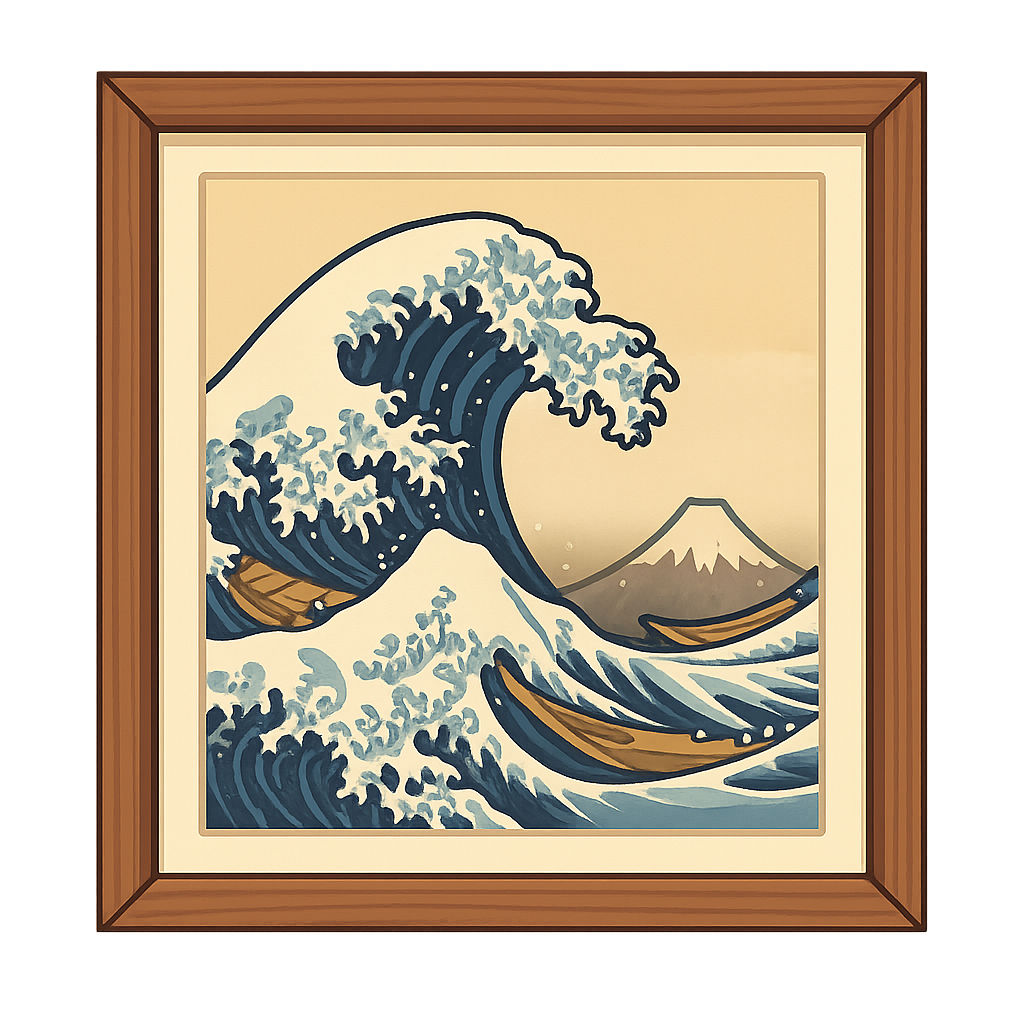The Great Wave Off Kanagawa
Imagine being a mountain made of water. That's me. I rise from the deep, deep sea, my body a swirling mix of dark, rich blues. I grow taller and taller, gathering all the ocean's energy until my peak scrapes the clouds. My top curls over, and white foam explodes like a lion's mane, my watery claws reaching for the sky. Below me, the world looks so small. I see little fishing boats, like tiny leaves tossed about in a puddle. The fishermen inside them hold on tight, their faces turned up towards me in complete awe and maybe a little bit of fear. Can you blame them? I am a roaring, churning giant. Far in the distance, a real mountain stands perfectly still. It’s Mount Fuji, its peak covered in a quiet blanket of snow, watching me with ancient patience. It is calm and steady, while I am all movement and noise. I am the raw power of the ocean, a moment of wild energy frozen in time. I am The Great Wave Off Kanagawa.
I wasn't always a famous picture; I started as an idea in the mind of a brilliant artist. His name was Katsushika Hokusai, and by the time he dreamed of me around the year 1831, he was already an old man with a paintbrush in his hand and endless curiosity in his heart. Hokusai was completely fascinated by Mount Fuji. He wanted to capture its beauty from every possible angle, in every season, and during every kind of weather. His big project was called 'Thirty-six Views of Mount Fuji,' and I was meant to be one of those views. But Hokusai didn't just want to paint a mountain. He wanted to tell a story about the relationship between the mighty, calm mountain, the wild, powerful nature of the sea, and the brave, small humans who lived between them. To bring me to life, he used a special Japanese art form called ukiyo-e, or woodblock printing. First, he drew me with his masterful brushstrokes. Then, skilled carvers took his drawing and carved it onto blocks of wood. Can you imagine carving every drop of my sea spray and every curve of my crest into hard wood? They had to make a separate block for each color. There was a block for the pale sky, one for the yellow boats, and of course, one for my magnificent blue. And that blue was special. It was a new, vibrant color that had just arrived in Japan from far away in Europe. It was called Prussian blue, and it made me pop off the paper with a depth and energy no one had ever seen before. Finally, printers would carefully apply the ink to each block and press them onto paper, one after the other, until I emerged, perfect and powerful.
For many years, I lived only in Japan, admired by the people there. But in the mid-1800s, Japan began to open its ports to the rest of the world. Ships sailed in and out, carrying tea, silk, and art. That’s how I began my great journey. Copies of me were packed up and traveled across the vast oceans I depict. I arrived in Europe, in cities like Paris, and artists there had never seen anything like me. They were used to very different kinds of paintings. They were amazed by my bold lines, my flat, brilliant colors, and the way the whole scene was framed, with the giant wave in front and the tiny mountain in the back. Famous painters like Vincent van Gogh and Claude Monet studied me and were deeply inspired. You could say I made a huge splash. My journey didn't stop in the 1800s. I have kept traveling through time. Today, you can see me almost anywhere you look. I’m on posters hanging in bedrooms, on t-shirts, on coffee mugs, and even as giant murals on city walls. I am a reminder that a single moment, captured on a piece of paper with a bit of ink and a lot of imagination, can connect people across hundreds of years and thousands of miles. I show the awesome power of nature and the incredible creativity of human hands, asking everyone who sees me to stop and wonder at the beautiful, wild world around them.
Reading Comprehension Questions
Click to see answer
